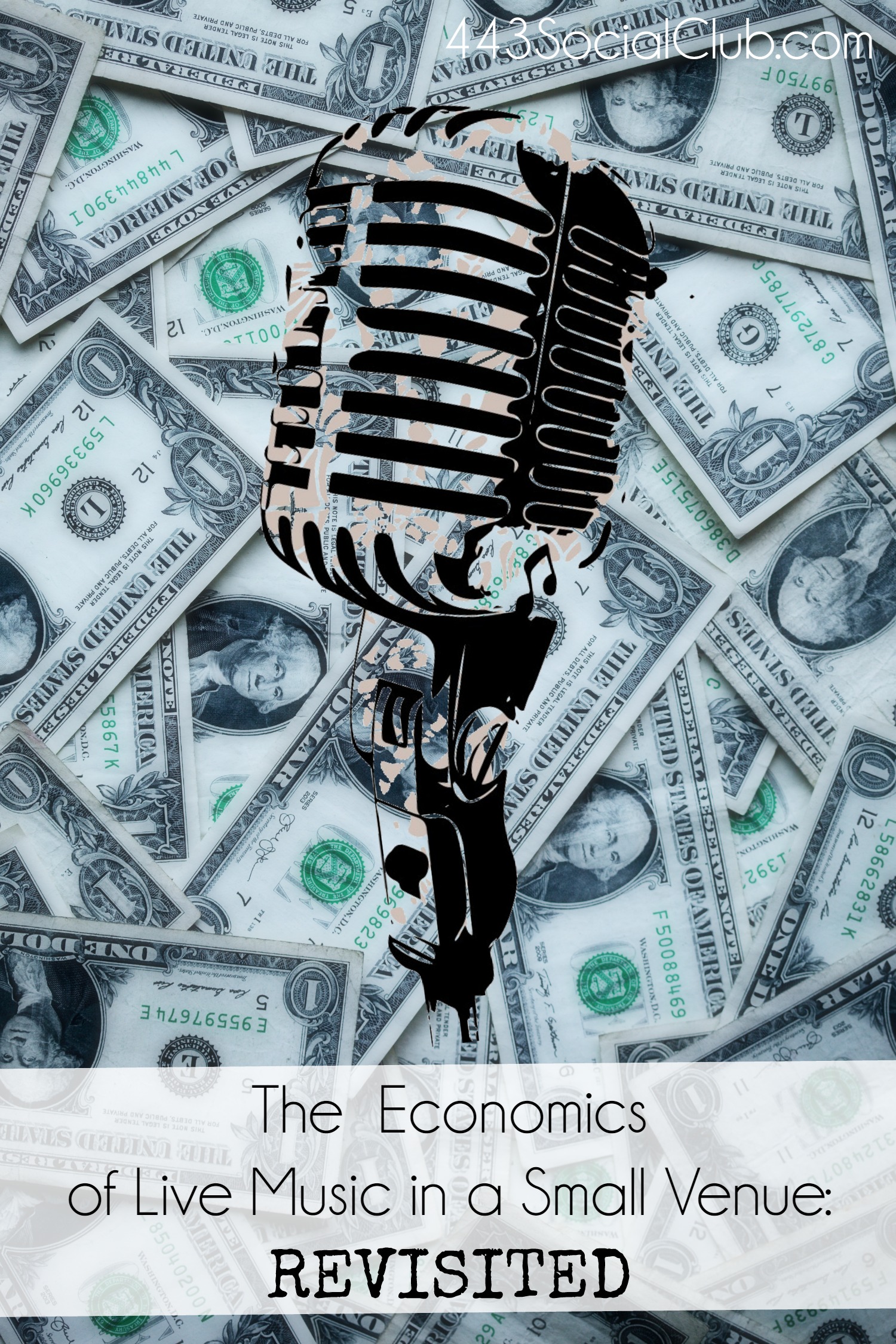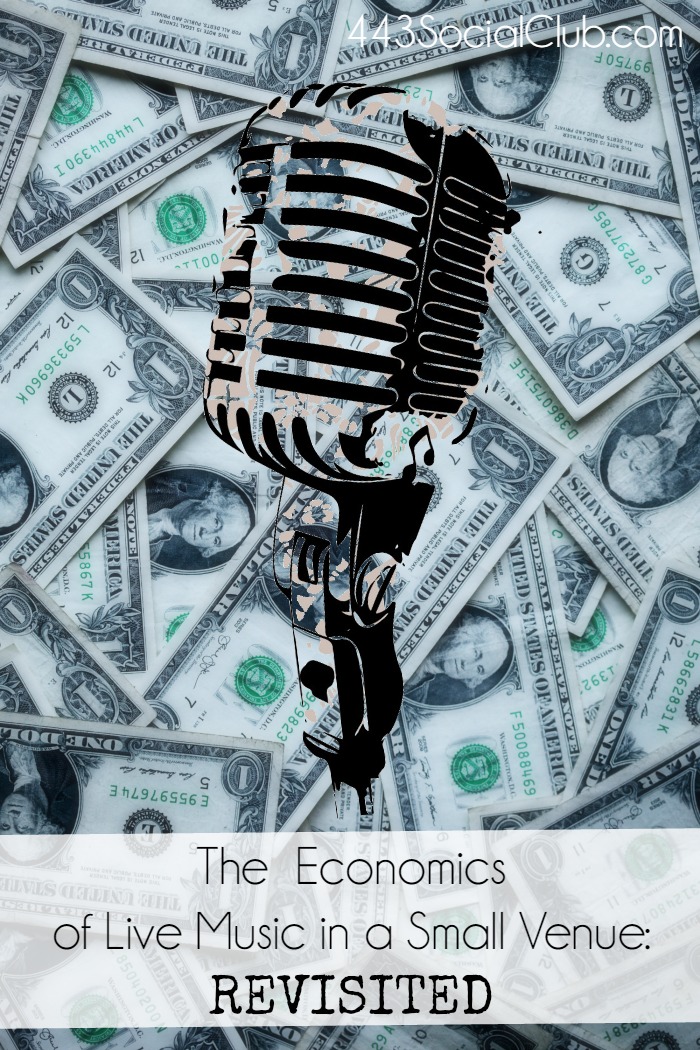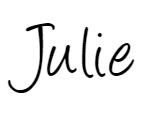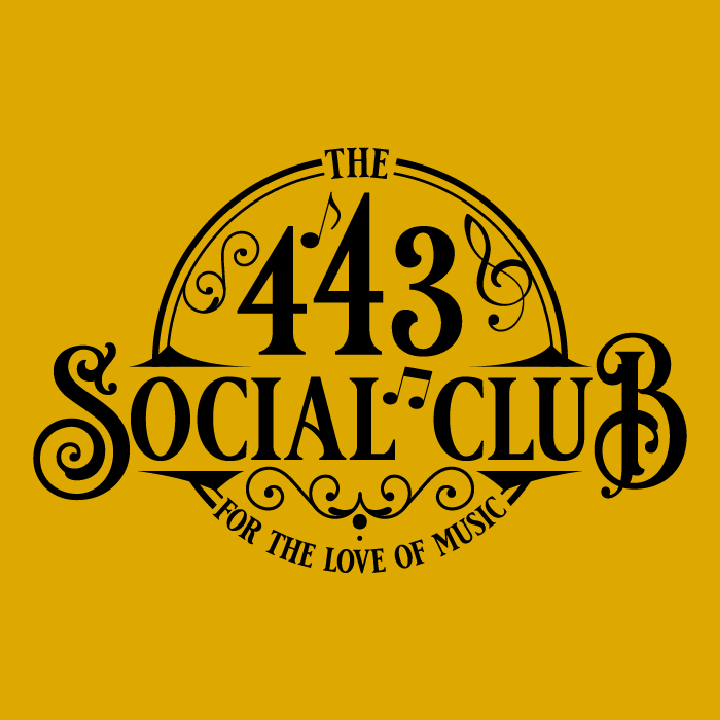
Last December I wrote a blog post called The Economics of Live Music in a Small Venue. I wrote it about a month before we opened, as I was working on filling our calendar for the first time.

Interestingly, it is the only post I’ve written that gets consistent traffic nearly every single day.
In that post, I broke down the numbers involved in booking live music in a small venue and worked out how many drinks a bar needs to sell to cover the price of a band before they can begin to chip away at their own overhead.
When we opened our doors back in January, our shows ranged from free to a $5 cover to ticket prices ranging from $10 to $25. We suspected the free model was going to be difficult to sustain, but we figured we would try it for a few months and see how it went. We wanted as few barriers as possible for people to check us out for the first time.
If you haven’t clicked over to my first blog post, the point of the article was to break down in real numbers how much it costs to present live music to the public. A $250 solo or duo requires the sale about $370 worth of drinks (assuming a 75% profit beyond the cost of goods), or about 61 drinks and a larger band charging $400 requires $530 in sales or about 88 drinks to break even on the entertainment.
There are 2 important takeaways here:
- THAT IS A LOT OF DRINKS
- Hitting that number doesn’t contribute one penny to the bar’s overhead.
Overhead at a typical bar isn’t cheap – you’ve got payroll + the payroll service fees, taxes, workers comp, business insurance, rent, National Grid, internet, water, trash removal, alarm system, advertising/marketing, a whole roster of expensive annual permits, a hefty liquor license fee, ASCAP, and BMI.
We have learned a lot in our first 8 months.
The ticketed shows tend to work out best, as long we sell enough tickets to cover the guarantee.
Most touring artists are a ticket split of some sort, typically an 80/20 split vs an agreed-upon guarantee. Let’s say the deal is a $300 guarantee vs an 80/20 split with $15 tickets. This means that no matter what happens, I am agreeing to pay the artist $300 – even if we don’t sell ANY tickets. I need to sell 20 to cover that guarantee, but our goal is to sell more so the 80/20 split kicks in. Ideally, the 20% we get is enough to cover our in house sound tech, pay the person at the door collecting money and any extra advertising we did to promote the performance.
We definitely took a bath on some ticketed shows we did in our first few months, so I’ve gotten a lot more cautious about who we book and the deals I’m making. It means I can’t always book bands I think are fantastic because I’m worried about selling enough tickets. I have to make the economic decision rather than the artistic choice.
A show with a $5 cover charge can work great too if a reasonable number of people show up.
For a local band, we typically offer a flat guarantee, but we’ll charge 5 bucks at the door to help defray that cost plus the sound tech and the person at the door. If we don’t make enough at the door the artist still gets their guarantee. Any surplus after everyone is paid goes to the band.
When we cover our musical expenses at the door, IT WORKS.
Free shows are a different story…they don’t work, even with a full room.
We are not a place where college-age kids drink until they fall down. We cater to adults and adults tend to drink better quality booze, but less of it. On our busiest nights, with a full room of people eating and drinking and our staff jamming, there seems to be a limit to what we can do in sales – and that number is not high enough to cover a band and sound tech with much (if anything) left over to cover our own expenses.
We feel strongly that we should pay the amount we agreed on, no matter how poorly attended the show was. After all, a deal is a deal. If the artist recognizes the low turnout and negotiates a lower fee, we do sometimes agree to a different amount – but the ball is in their court.
It’s the right thing to do, but what it means in real life is paying out 50% or more (sometimes MUCH more) of our gross sales for the day – and it doesn’t take a math genius to recognize that model is a fast track to going out of business. For one recent show, we paid out 118% of our sales for the day between the band and the sound tech, and we made just enough at the door to cover the person taking the money.
Yes, you read that right – we paid out MORE than we took in.
Another time, I was chatting with a musical duo after their first performance with us and the singer said, “I’m so sorry we couldn’t get more people to come in” and the guitar player looked at the 20 or so people in the room and said, “Why? This looks like a pretty good turn out”.
For context, I had just handed them 56% of my gross sales – and there wasn’t a cover charge that night.
I’m sure my jaw dropped. The dissonance between the artist and the venue owner is an interesting thing.
On the rare occasions I get out to see a band at a different venue, I catch myself looking around and calculating the financial side of it because it’s so much on my mind lately. Some places can make it work without a cover because they are a restaurant with a full kitchen, and they don’t start the music until after their dinner crowd leaves. Bigger bars can pack more people in…but it’s a different story for small venues. I recently went out to see a band in a small bar that does not charge a cover and does not sell food. I know this 5+ piece band charges about $500. I was watching what people were buying, taking note of how many people fit in the room and all I could think was, “How the hell are they making this work?!?”
We have gradually been adding a cover charge to more and more of our shows, and as we move forward you’ll see a $5 charge on all our local shows. I was concerned about trying this with artists who play in town with no cover, but we’ve been relieved to find that we can still fill the room, even with the door charge. Your $5 cover charge pays the band, but you’re also getting a top-notch sound system, a comfortable place to sit, groovy atmosphere, and stellar service. You are paying for the music AND the unique experience of The 443.
And frankly, it just can’t happen any other way. If we discover Syracuse is unwilling to pay a nominal cover to hear quality, original live music from local bands, we will have no choice but to eliminate local music from our calendar. It would be a shame, but we can’t keep our doors open if we’re working just to pay the band.
The idea that live music is something you should always get for free isn’t realistic…there are very real costs. Consumers balking at a cover charge or ticket price will mean fewer venues offering live music and fewer places for musicians to play – and neither one of those things is good for our community and local music scene.
The two exceptions are Rock Bingo Music Trivia on Tuesdays and Acoustic Open Mic on Thursdays. We pay a DJ service to run Rock Bingo and we pay our host band and sound tech for open mic, but they will remain free. On those nights we have to cover our entertainment expenses through food and drink sales. Some venues have a minimum required spend policy (The Listening Room Cafe in Nashville is $15 per person), but we have decided not to go that route.
I had so many people comment on my original post that I thought it was worth circling back to with real-life experience under our belt. I hope my dollars and cents breakdown of how it all works gives music lovers some food for thought next time they are faced with a cover charge at the door of their favorite venue.
See you soon!

